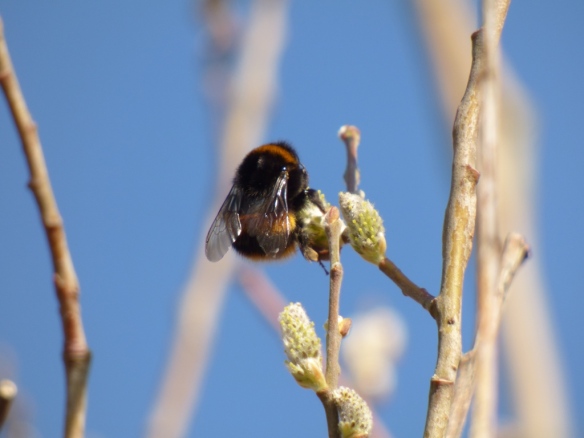First it was Battleby, then it was Flanders Moss, and now we have a fabulous new pollinator trail at Taynish National Nature Reserve. Who better to give us an update on what you can expect to find there than our colleague Caroline Anderson, who many of you will know is exceptionally talented with a camera. However, Caroline has a way with words too, so feast your eyes, and soak up the atmosphere, in the first of what will be regular monthly updates.
“Prior to the Pollinator Trail signage being installed at Taynish NNR, I walked the proposed route on what was the hottest day of the year so far. Starting at the car park, I was astounded at the number of wild flowers adorning the banking; bluebells, wood anemone, violets, stitchwort and celandine just glowing in the sunshine.

As I walked along the path I could see that the hawthorn is about to bloom, and the ivy and honeysuckle cling to the trees with their new growth, ready to welcome any visiting insects – these are particularly great for moths.
“I took a left onto the boardwalk and, oh joy of joys, the damselflies were back! It was really lovely to see the Large Reds after a period of 6-months absence. The warm weather obviously did the trick and brought these welcome visitors out.


From the boardwalk I found a 7-spot ladybird and an alderfly (covered in pollen.) The lochan is host to a vast array of water boatmen and will soon be host to a large number dragonflies and damselflies ducking and diving amongst the water lilies.
Back onto the trail I stopped at the second bench on the path – looking right into the heather and bog myrtle and there were more damselflies flitting between the shrubs.
Onto the sluice – again a favourite for water loving insects and damselflies. Past the sluice a path goes through the wood on the left-hand side. I followed the path to what is thought to be the remains of a round house. Next to the remains is a tree blown over in a gale some time ago.

The root system of the tree is thought to be host to a colony of mining bees. However today, I spotted some squatters. Some nomad bees (Nomada marshamella) that lay their eggs in the nests of chocolate mining bees. Their larva feed on the food the mining bees bring to their own larva. They are parasites, but it was interesting to see them.
There were lots of Speckled Wood and Orange Tip butterflies on the wing, but they were particularly flighty today due to the sunny weather.


My next find was a very handsome and quite large longhorn beetle and if you look really closely you can see it is covered in small hairs.
Then on to The Mill. A loud buzzing interrupted the peace at the mill entrance. First I thought it was a bee, however on closer inspection it turned out to be several bee flies. Brilliant pollinators, they look a bit daunting with a large proboscis and long legs, but they are completely harmless and only interested in nectar.


The blossom on the cherry trees is falling like confetti. And the newly cleared area next to the mill is already attracting hoverflies and bees. One particularly large buff tailed bumblebee could be seen walking along the ground on the cleared area.
I carried on down to the shore for a welcome rest on the Poets Seat then back along the trail to the car park. There is no doubt that Taynish NNR is a perfect place to site a pollinator trail having blossoms and plants in abundance to attract the pollinating insects. I am excited to see what develops over the coming weeks.”
Till next month…. Caroline
All images courtesy of and copyright Caroline Anderson.






















